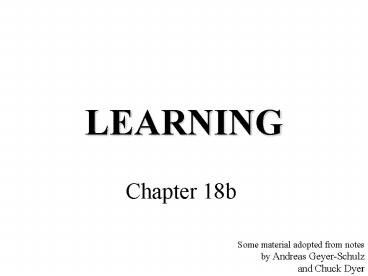LEARNING - PowerPoint PPT Presentation
Title:
LEARNING
Description:
Hypothesis Testing. and ... Any hypothesis that is consistent with a significantly ... Stationarity assumption: Training set and test sets are drawn from the ... – PowerPoint PPT presentation
Number of Views:19
Avg rating:3.0/5.0
Title: LEARNING
1
LEARNING
- Chapter 18b
Some material adopted from notes by Andreas
Geyer-Schulz and Chuck Dyer
2
Hypothesis Testing and False Examples
3
Version Space with All Hypothesis Consistent with
Examples
4
The Extensions of Members
5
Computational learning theory
- Intersection of AI, statistics, and computational
theory - Probably approximately correct (PAC) learning
- Seriously wrong hypotheses can be found out
almost certainly (with high probability) using a
small number of examples - Any hypothesis that is consistent with a
significantly large set of training examples is
unlikely to be seriously wrong it is probably
approximately correct. - How many examples are needed?
- Sample complexity ( of examples to guarantee
correctness) grows with the size of the model
space - Stationarity assumption Training set and test
sets are drawn from the same distribution
6
- Notations
- X set of all possible examples
- D distribution from which examples are drawn
- H set of all possible hypotheses
- N the number of examples in the training set
- f the true function to be learned
- Approximately correct
- error(h) P(h(x) ? f(x) x drawn from D)
- Hypothesis h is approximately correct if error(h)
e - Approximately correct hypotheses lie inside the e
-ball around f
7
- Probably Approximately correct hypothesis h
- If the probability of error(h) e is greater
than or equal to a given threshold 1 - d - A loose upper bound on the number of examples
needed to guarantee PAC - Theoretical results apply to fairly simple
learning models (e.g., decision list learning)































